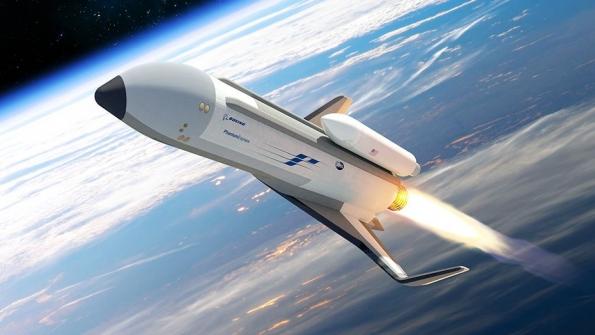
LOS ANGELES—Boeing has abruptly ended its participation in the development of the Phantom Express reusable launch vehicle, effectively terminating DARPA’s XSP (Experimental Spaceplane) program for which it was being built.
No specific reason has been given for the sudden move, which comes as Boeing looks to cut costs under new CEO Dave Calhoun amid the ongoing crisis over the grounding and production halt of the 737 MAX airliner. The company says termination of the XSP followed a detailed review of the program and adds that “we will now redirect our investment from XSP to other Boeing programs that span the sea, air and space domains.”
DARPA, which began the spaceplane project in 2013 targeted at bringing aircraft-like, on-demand reusability for civil and space sectors, says work on the XSP conducted to date showed “no technical showstoppers stand in the way of achieving DARPA’s objectives, and that a system such as XSP would bolster national security. Through XSP, DARPA identified evidence that present-day liquid rocket propulsion systems are capable of supporting XSP objectives, remain of interest, and may be explored in separate efforts.”
Boeing, which was selected in 2017 to develop the XSP under Phases 2 and 3 of the DARPA program, worked on initial assembly of the test vehicle through last year and was due to start flight tests in 2021. Leveraging know-how from the space shuttle and X-37B developments, the vertical takeoff and horizontal spaceplane program was due to culminate with an intense demonstration phase in which the booster was to launch and recover 10 times in 10 days.
As well as proving the concept of flying on demand, the XSP effort was also aimed at demonstrating the potential for cost-effective turnaround between flights; a low ground infrastructure footprint, and low recurring costs. Despite the termination, DARPA says the program achieved several other technical goals including the successful development of the vehicle’s liquid oxygen (LOX), liquid hydrogen (LH)-fueled Aerojet Rocketdyne AR-22 rocket engine, a derivative of the company’s reusable RS-25 space shuttle main engine.
The fundamental ability of the 375,000 lb.-thrust engine to perform at the tempo required for the XSP program was demonstrated when back-to-back runs at full throttle were completed over 10 days in 2018 at NASA Stennis Space Center, Mississippi. DARPA says the liquid rocket vehicle configuration was shown to have the “operability and maintainability similar to an airplane.”
Other accomplishments included a “detailed understanding of both civil and military mission architectures well-suited for a system such as XSP: the environments and dynamics of deploying an upper stage carried in parallel with the booster, and the design and fabrication of liner-less composite tanks for cryogenic propellants.”
Development of the cryogenic-carbon composite LOX tank leveraged advanced fiber placement techniques used by Boeing during development of the 787 airliner and during a Composite Cryotank Technologies and Demonstration (CCTD) project with NASA. The structure was almost 40% lighter as well as cheaper than conventional aluminum-lithium cryogenic fuel tanks and would have been the first of their kind to fly as the XSP continued.
Boeing also developed the much larger liquid hydrogen tank which was almost double the size of the oxidizer vessel. Together the two propellant tanks would have made up two-thirds of the length of the 100-ft.-long spaceplane.





